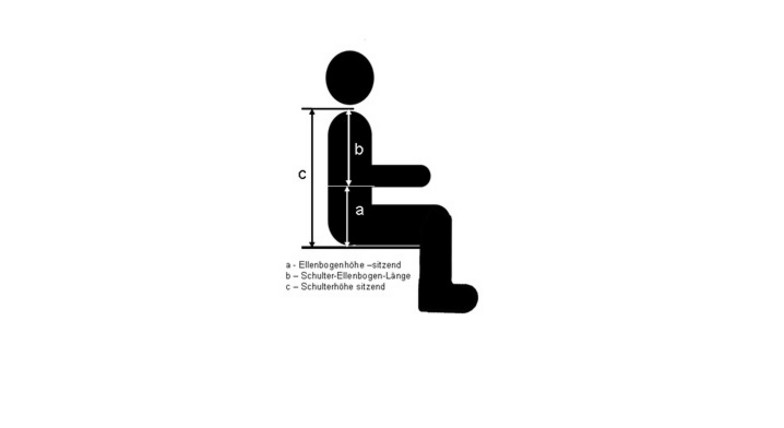Percentiles for a body dimension (e.g. for the body height) always apply to the dimension concerned in isolation; they cannot be combined with other percentiles. For example, where a short woman has a body height equal to the 5th percentile, her other body dimensions will not necessarily also be equal to their respective 5th percentiles.
EN ISO 3411 for example states the respective values for the 5th, 50th and 95th percentiles of the body height for small, medium and large operators. The same procedure was followed for the other body dimensions, for which the value of the 5th percentile was stated as the smallest dimension, that of the 50th percentile as the medium and that of the 95th percentile as the largest dimension to be considered. The table header indicating small, medium and large (machine) operators implies however that all dimensions of a small (i.e. short) machine operator would be small and that the values for the 5th percentile would apply to each dimension (see table below). This assumption is however incorrect.
| Designation | Dimension (mm) | ||
|---|---|---|---|
| Small operator | Medium operator | Large operator | |
| Stature (with shoes) | 1 550 | 1 730 | 1 905 |
| Arm span | 1 585 | 1 765 | 1 905 |
| Chest depth | 210 | 247 | 280 |
| Abdominal depth | 210 | 257 | 300 |
Owing to different trends in physical growth (body type), body proportions differ from one person to the next. Tall people for example are often slim, smaller people often portly. Relatively often, shorter machine operators may exhibit dimensions for the abdominal depth that lie for example between the values of the 50th and 95th percentiles. Equally, for a given body height, the ratio between the trunk length and leg length differs, leading to "seated giants" and "seated dwarfs" (see following image and also the FAQ). Individuals exist with a body height below the 50th percentile (e.g. 1,715 mm, which is just below the value of 1,750 mm stated in DIN 33402-2 for the 50th percentile of the body height of German men) whose dimension for the height sitting is greater than the 50th percentile (904 mm). If the dimension for their leg length is smaller than the value for the 50th percentile (812 mm) (data from Flügel et al. 1986), such individuals are "seated giants", i.e. tall when seated. Conversely, if their leg length exceeds the 50th percentile and their height sitting is below the 50th percentile, they are "seated dwarfs" (short when seated).
Since length dimensions correlate, "seated dwarfs" generally also have relatively long arms, seated giants relatively short arms. Further differences in proportions are those between men and women.
Although several people may exhibit very similar values for one body dimension, it must always be assumed that they may differ significantly in the majority of their other body dimensions. This phenomenon can be demonstrated effectively by a simple arithmetical example for the shoulder height sitting:
If every individual whose shoulder-elbow length corresponded to the 5th percentile could also be assumed to have an elbow height corresponding to the 5th percentile, it ought to be possible to add these two dimensions together to obtain the shoulder height sitting, as shown in the image below. Measurement path a plus measurement path b should therefore produce measurement path c:

The example of the P5 values stated in CEN ISO/TR 7250-2 for German women shows that this is not permissible. If the value for the shoulder-elbow length of 290 mm is added to the value for the elbow height of 185 mm, the sum is 475 mm, which – in purely arithmetical terms – yields the shoulder height sitting. The actual figure stated in the standard (CEN ISO/TR 7250-2) for the shoulder height sitting is however 540 mm, i.e. a difference of 65 mm. Whereas summation in this way does not present problems during calculation of the body dimensions of an individual person, it is not therefore permissible with percentiles.